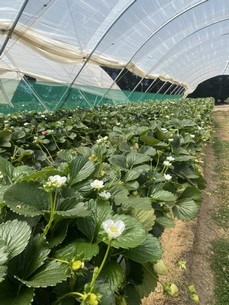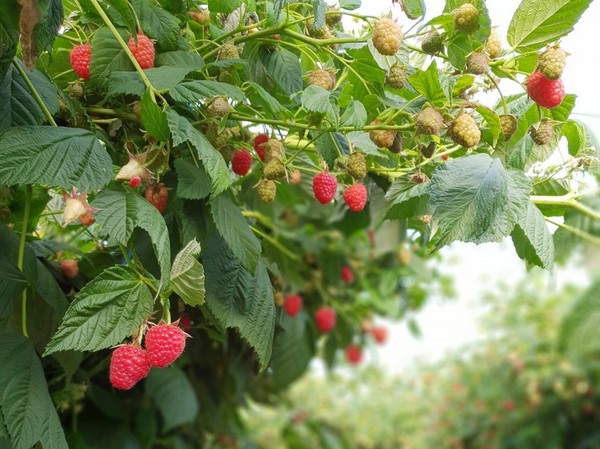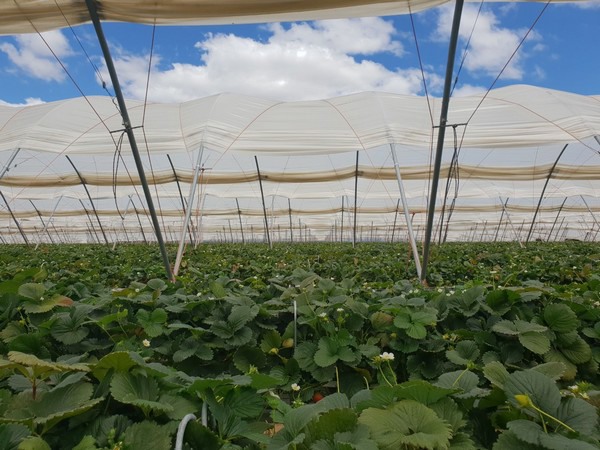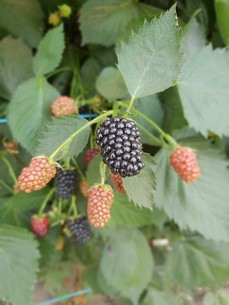 Originally from New Zealand, Laurie Adams emigrated to the UK in 2000 where he stayed for 20 years working with a range of different soft fruit businesses including Haygrove and Hall Hunter Partnership. At the beginning of 2020 he moved out to Australia and took up the position of General Manager with Tasmanian soft fruit grower Burlington berries.
Originally from New Zealand, Laurie Adams emigrated to the UK in 2000 where he stayed for 20 years working with a range of different soft fruit businesses including Haygrove and Hall Hunter Partnership. At the beginning of 2020 he moved out to Australia and took up the position of General Manager with Tasmanian soft fruit grower Burlington berries.
Burlington Berries grows strawberries, raspberries, and blackberries over 50 hectares. Laurie compares soft fruit growing in the UK with growing in Australia.
Growing methods
 The growing set up between the two counties is quite similar, especially in the south and Tasmania, in that it is mostly tunnels, but obviously they have very different climates.
The growing set up between the two counties is quite similar, especially in the south and Tasmania, in that it is mostly tunnels, but obviously they have very different climates.
“For strawberries there are two growing seasons in Australia, the winter season which is mainly in the north in Queensland and a lot of that is uncovered, also in New South Wales and Victoria there is uncovered production. The summer season which is increasingly supplied from Tasmania is predominantly under cover in polytunnels (around 90%), and grown in similar systems to the UK and northern Europe.
Mechanisation
“I think it’s fair to say that development in mechanisation is more advanced in Europe, in terms of picking robots, there are 2 or 3 projects in Australia and those are projects which have been developed with the US and Europe. They will do trials in the Northern Hemisphere season and they come to Australia for the Southern Hemisphere season to get two seasons in one year. Burlington works with Dogtooth Technologies on a robot for strawberry harvest during our season, then they go back to work on the farms in the UK.

“There has been significant progress in mechanising strawberry picking, I think that within a 3–5-year window you will see commercial harvesting done by robots. Australia may be a bit behind the UK, but there will be early adopters here as well as in the UK. Initially you will see robots harvesting alongside humans, you won’t be able to replace the entire workforce, as you won’t be able to manage the peaks of production, but they will be able to generate data to figure out the algorithms and this will drive the speed increase and accuracy. There is already a robot which goes along the tunnel with an arm to pick the strawberries, now it needs to gather more data for more accuracy. Currently the robots are only getting about 60-70% of the fruit which need to be harvested so a human picker must go behind it. The work that is being done is predominantly for strawberries, there is work going on for raspberries but that is a long way behind the projects for strawberries.
Pesticides
“Both countries are very similar in their approaches to chemicals and which ones they use. Both are also very focussed on developing new varieties, plant types, crop systems and a growing environment which is not conducive to pests and disease. This development complements the existing work on biological controls and other IPM strategies. All the same concerns are on the radar here and the development of crop system to manage that change are in development here.”

Marketing
A large proportion of the UK production is programmed to the retailers, while at Burlington Berries the fruit is marketed and distributed by Driscolls, the largest marketer for soft fruit in Australia, so the Australian crop will predominantly be marketed between companies like Driscolls and the main retailers Coles and Woolworths.
Labour
The labour supply is one thing which differs a lot between the countries: while there are shortages in both Australia and in the UK, Australia has a much broader pool according to Laurie.
 “In Australia there are local and backpacker workers as well as workers who come from the Pacific Islands, whereas in the UK the main source has been from Eastern Europe.”
“In Australia there are local and backpacker workers as well as workers who come from the Pacific Islands, whereas in the UK the main source has been from Eastern Europe.”
Since the decision was made to leave Europe there has been a major transition in the labour supply and a lot of uncertainty which is a big challenge to growers, including moving back to a visa system like SAWS.
“In Australia, the labour supplied from the Pacific Islands is mutually beneficial. For every 5 people who come to work in seasonally Australia we can employ one local Australian worker full time, creating permanent work. It is a win-win situation.”
The harvest is at its peak now in Tasmania and Burlington Berries has enough workers, but some other growers in Australia have not been so fortunate and have had to leave fruit in the crop.
“We have a long season which encourages pickers to come here. The Tasmanian government is also very supportive, in Australia each state has a lot of say in the local decisions whereas in the UK decisions are made country wide. Tasmania has a large amount of agriculture and horticulture which helps to focus the minds of local politicians.
UK vs Australia - which is best?
When asked which country is best to work and live in Laurie gave a very diplomatic answer: “Well, right now I would have to say Australia, we have been lock down free for a while now with no restrictions, the kids can go to school so we all feel very lucky. The only downside is not being able to travel abroad to see our families, which is the same for people all over the world.”
For more information:
Laurie Adams
Burlington Berries
laurie@burlingtonberries.com.au
www.burlingtonberries.com.au
